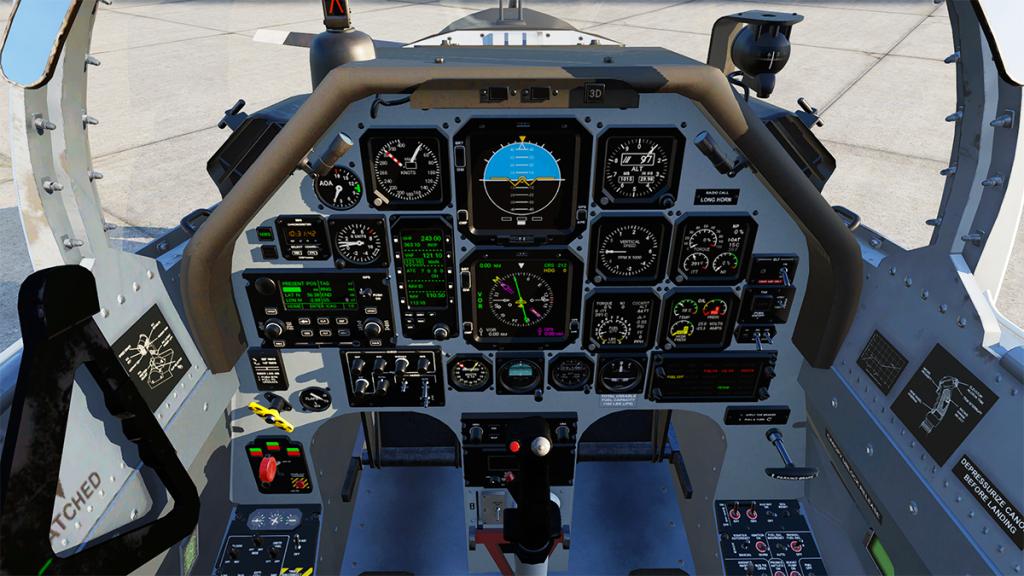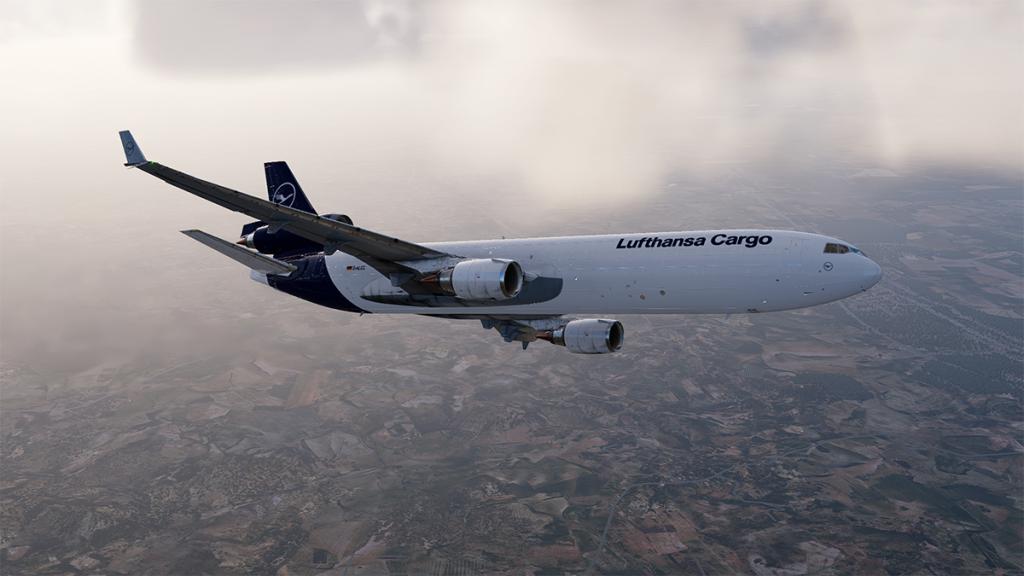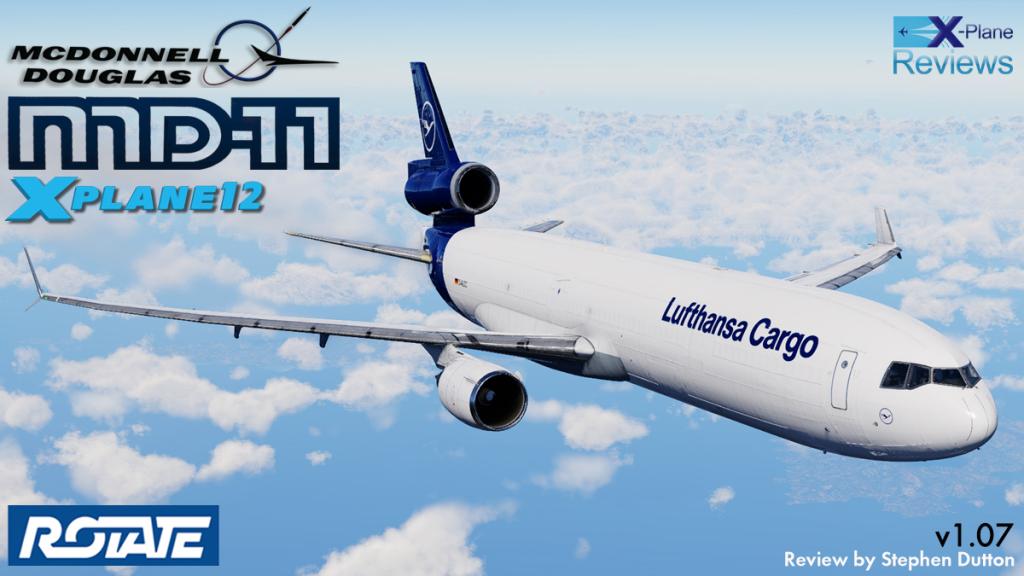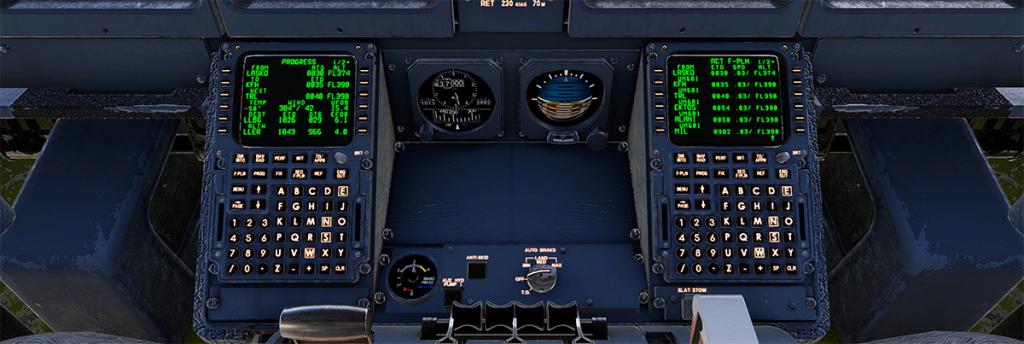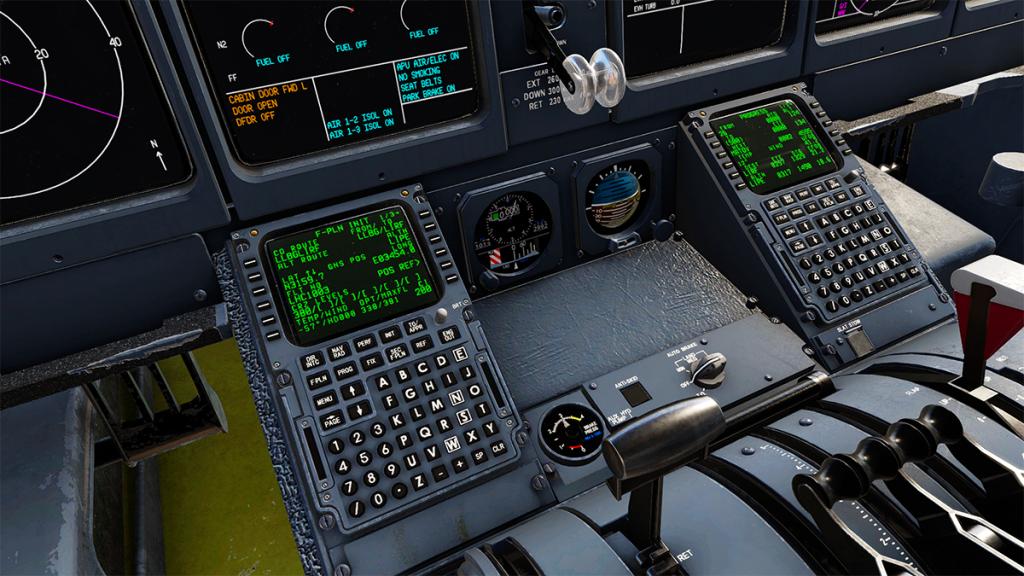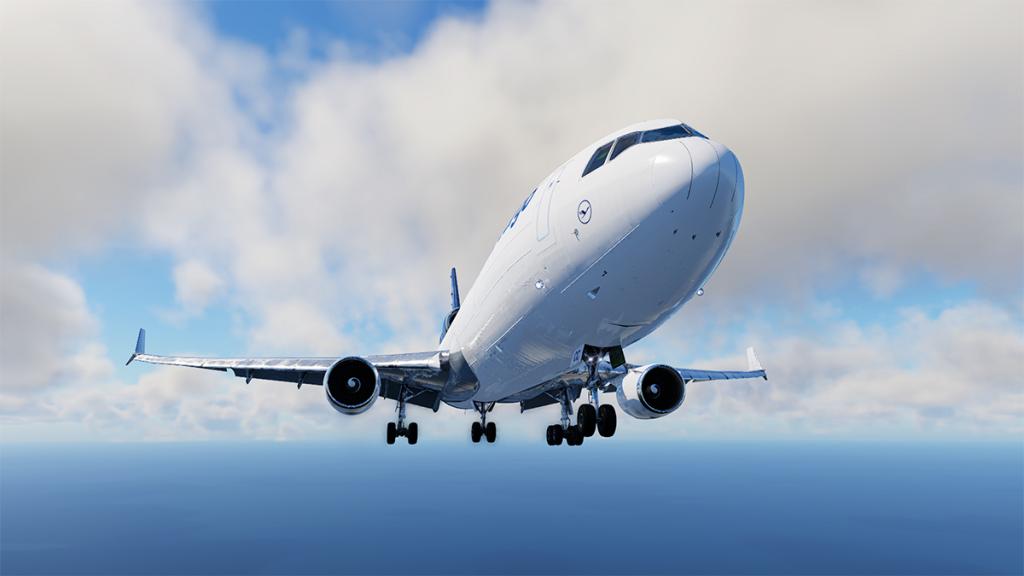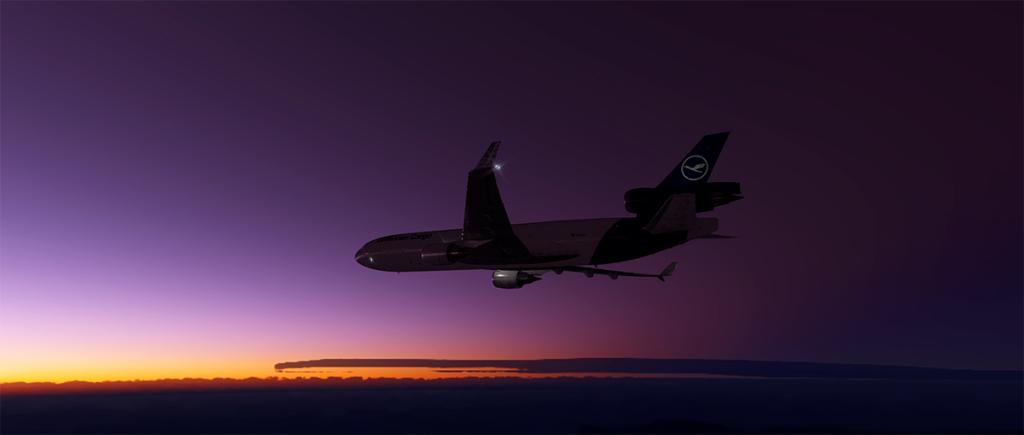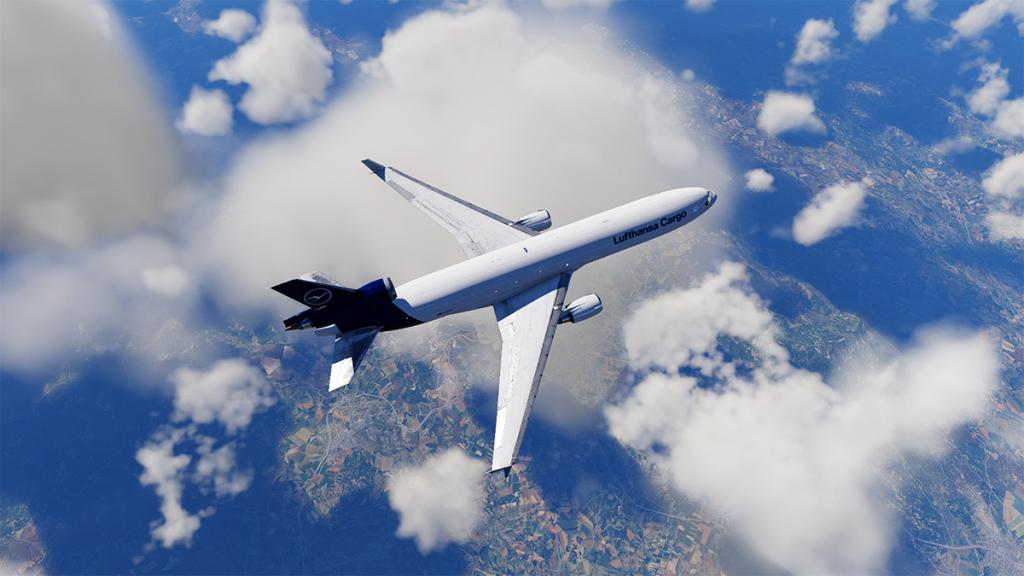Leaderboard
Popular Content
Showing content with the highest reputation on 03/10/23 in all areas
-
Aircraft Review: AOASimulations-T6A Texan II X-Plane 12 By Stuart McGregor Introduction The release of the AOA T-6A Texan ll was done in the change over twilight zone of a legacy version with its ground-breaking advancements that was achieved with X-Plane 11, which essentially is at the end of its commercial run, and the eagerly awaited X-Plane 12, which still had some way to go until it is in its final release state in December 2023. For us armchair pilots this can be a little frustrating in our 365, 24/7 on-the-go world, where patience isn’t a commodity you see a lot of these days, so I can only imagine the dilemma this gives commercial developers. Do you wait until all the i’s are dotted and t’s crossed in X-Plane 12, or do you continue creating and releasing in X-Plane 11, knowing the platform has been superseded by its younger brother? AOA Simulations decided not to wait to bring us their ‘Texan’, the T-6A Texan II. The aircraft was released for X-Plane 11, with a commitment of a free upgrade to X-Plane 12 for existing users when the simulator upgraded to the new version. That X-Plane 12 release has now happened, and to top off the T-6A package you get both versions for X-Plane 12 and X-Plane 11. In real life, the Texan is described as a single-engine turboprop aircraft and has been around since the late 1990s. It has been used as a training aircraft by several military organisations around the globe and more than 850 have been built to date. From what I have read, it is still very much the mainstay of the United States Air force and Navy when it comes to pilot training. It has a low wing cantilever design with the majestic Pratt & Whitney PT6A-68 1100 hp engine, tandem seating arrangement with ejector seats to allow the flight instructor and trainee to live every moment together, all topped off with a hefty four-blade constant speed, variable pitch prop. The Texan also has a retractable tricycle landing gear assembly, with many of the features being based on the original development aircraft, the Pilatus PC-9. However, don’t be fooled, because the Texan is indeed a very different aircraft in many ways. To explain this in greater detail, the AOA Simulations folks have included a very nice reference document in the manuals section of their package that describes the Texan’s development journey. This is well worth a read to see just how much it has changed from the original Hawker Beechcraft development PC-9. I personally always like additional features like this because in my opinion they bring a greater level of depth to the user experience and allow a more immersive environment when you know a bit about the aircraft, its history and how it came into being. Documentation I will be honest and say that military jets and combat aircraft are not an area I typically venture into very often, so when I had the opportunity to try out what looked a bit like a fighter jet with a prop on its nose, I was intrigued to find out more. My GA side was screaming, “Oh yes please!” The package in review comes in a 360MB download with the aircraft itself and a couple of liveries, as well as a few added extras in terms of documents. In the Manuals folder, you will find an alternative abbreviated checklist (X-Checklist plugin is required) to the one provided by default, a paper kneeboard checklist you can print, emergency procedures, a training flight tutorial with charts (KNGP to KRND), pictorial overviews of flight instruments, and if you are a MAC user, there is an explanation of a workaround if you experience issues when you first load the model. There is also a highly detailed 38-page User Guide to take you through every inch of the aircraft and that is a must-read if you really want to get the most out of the Texan. The developer has also included some contact details and links of where to request help if you get stuck. Sadly, I can’t offer any comment on how successful the MAC workaround is, as I use a PC, however it looks like the developer has put some serious thought into the issue which is good to see. The Aircraft The developers quote that their Texan has been in development since early 2020 and clearly a huge amount of work has gone into the aircraft. You get a real sense of the details and the hours of work by just reading the manual alone, so I believe it is fair to say that the Texan really does come fully loaded. I loved the fact that both the front and rear cockpits are fully functional, thus providing a unique flying experience from each seat, and it was nice to be able to have the choice. The internal details in both cockpits are well presented and bristle with features. The texturing is of high resolution and high quality, and I found reading the various dials and panels to be of no issue, even in VR, when using my Rift S. The developers even quote that the Texan has been optimised to maximise performance in VR, and I would have to admit, that when using my system, I had no issues and enjoyed a very smooth experience. When you first step into either cockpit, it is a bit daunting if you’re not used to military-style aircraft, however, the automated tutorial-level Checklist provided is very useful when navigating around the various systems. In my tests, I probably only scratched the surface of the instrument capabilities of the Texan, and you literally could spend hours and hours just working through your flows and testing out every feature, switch, lever, knob, button, panel, and fuse. As far as I could tell, everything shown works or is at least animated. If you are used to flying fast jets, I am sure the layout will come very naturally to you, however, I must admit it did take me a little time to work my way around. By the way…the ejection seat does work, so be careful with that handle!!! The unobstructed view that the glass canopy offers, is truly excellent, particularly in VR, and you really get a sense of just how compact and well-fitted everything is around you. The feeling of being in the cockpit was something I really enjoyed, and as I mentioned previously, just moving a few feet back to sit in the rear seat, adds a totally different dimension to the experience. The Texan comes with specially created FMOD sounds and the cockpit interaction sounds were nicely done, from the very subtle fuse click actions to the more distinct canopy locking mechanism. From the X-Plane main menu bar, you can access the dust lock removal option, as when in cold and dark, there are several covers protecting sensitive parts of the aircraft. Even these covers are well modeled, as they sway gently in the wind, a very nice touch and great attention to detail. From the outside when the canopy is open in cold and dark, there are no pilots visible, however, they both appear when closing the cockpit and removing the dust covers. The characteristic turbine whine as the engine starts up is very nice, and you really do have the sense of that mighty Pratt and Whitney engine roaring into life right beside or in front of you. As you move around the exterior of the aircraft, the engine tone changes as you would expect, and this is particularly noticeable when you throttle forward and set the Texan into action. The sense of power from the 1100hp engine and prop thrashing through the air as you accelerate down the runway is something you must experience to really appreciate it. The exterior details of the Texan are superb in my opinion and incorporate very high-quality textures, such as the hydraulic lines in the landing gear, through to the multitude of rivets across the shiny aircraft skin. During prefight, it is worth just taking a few minutes to walk around the aircraft and take in the quality of the modelling, and this is particularly impressive if you can do this in VR. You can literally walk up to the various parts and take a good look, reach out and almost touch the surfaces. There is a significant difference between the X-Plane 11 release version and the X-Plane 12 here. You will see far more detail added, and the surfaces are more highlighted than before, the result is a substantial and better overall realism to the aircraft. The developers really have done a wonderful job both inside and out, and in my opinion, the Texan is one of the best in terms of overall appearance, although I do still think it is a little bit of an oddball with the fighter-style canopy, dual seating arrangement, and that big old prop at the front. It does take a little bit of getting used to at first. Now, if you’re anything like me, when you get a new toy, the first thing you want to do is to try it out, so the thought of working through a full set of start-up procedures may not be top of your list. The good news is that very early on, the developers thought of us “impatient types”, and kindly provided a very nice simple 11-step process on page 5 of the User Guide to get up and flying, and this is very helpful. Now don’t get me wrong, at times there is a real sense of satisfaction about going through every step of your flow and eventually seeing the ground disappear below, however, at times I just want to start up and off I go. I like the fact that in the Texan you can do both and I did, although I must admit that just firing up and heading down the runway was my preference. This is perhaps a suitable time to mention that I am using a VKBSIM joystick and pedal set as my control inputs, and I found these to work very well both on the ground and in the air. As there are no toe-brakes with these pedals, I did use a small script to give me brakes and this worked well, although there is a stick forward option that you can use within the aircraft if you prefer. I had no complaints about the handling of the Texan, although care with the throttle is highly advised both when taxiing and when taking off. There is a mighty amount of power at your fingertips, so my advice is to use it wisely. As they say, ‘with great power comes great responsibility…’ and never a truer word was said in the Texan’s case. Remember this thing can do more than 300 knots when flat out!! The glass canopy really does give an amazing view, particularly in VR, however, if you are using flat screens the developers have included a couple of highly novel add-on features to enhance your views in the cockpit. The manual goes into quite some detail to explain what you can expect; however, the best way is just to try them out. These are actioned via buttons on the glare shield and using dedicated buttons on your controller, and the ‘Roll to See’ feature allows you to pan around while taxiing, as well as some interesting effects when doing aerobatics. The Target Track feature allows you to lock on to AI aircraft if you are flying in formation (a key skill by all accounts) and if you are familiar with other aircraft from AOA Simulations, you are likely to be at home with this feature already. As I do most of my flying in VR, these features are disabled so I didn’t spend a huge amount of time testing them out, however from what I did see, this is quite unique and adds another and different layer of immersion to the Texan. One final system feature I would like to highlight is the Flight Assistance system which allows various assistance features to be turned on and off. The button is a bit fiddly to find (highlighted in the manual on page 11) however there are eleven different features such as AOA indexer and brake cues, airspeed indication of gear and flap speed bands, wind direction and speed, through to braking using the control stick and many more. The basic idea is to make life as easy as possible for any newbie pilot or as realistic as possible by switching this off for those who would like more of a challenge. When you are new to an aircraft, this sort of thing really does help, as there is nothing worse than getting frustrated and giving up before you have even started. The lighting is basic, mostly indirect lights on the the panels and the two side wall lights on the separate consoles. You can move the instrument panel spot lights to where you want them to shine on. Externally the landing and taxi lights don't work unless you lower the gear, as they are positioned on the inner gear struts. As I mentioned earlier, the Texan is fully loaded with so many great details and features, and although this type of aircraft is not necessarily my “go-to” happy place in the sky, the more I flew it the more I came to appreciate just how good an offering this is from AOA Simulations, both in terms of the basic aircraft but also just how enjoyable the overall flying experience can be. If you also like lots of technical details, procedures and everything that goes with that side of things, then again, I believe the Texan has something to offer you. Final Thoughts The T-6A Texan II from AOA Simulations, under normal circumstances, is an aircraft I wouldn’t typically be flying, however, I am glad I had the opportunity, as it’s always good to try something new. When you factor in the excellent internal and external textures, the 3D modelling, the control and integration of features, the sounds, and of course the flying experience, I think it’s fair to say that the AOA team really has put out an excellent product. Available now for both X-Plane 11, and to be experienced in X-Plane 12, all the new features in the sim in combination with the Texan’s feature set, it is something quite special. A real synergistic masterpiece… So, should you splash out $40 on the Texan? Well as always that is down to you, your budget and what you are looking for. However, I truly believe that the Texan is well worth thinking about, especially if you have considered the fast jet challenge but have not been sure where to start. If it’s good enough for real-world pilots, then it certainly works for me! __________________________________ The T-6A Texan II by AOA Simulations is now available from the X-Plane.Org Store here: T-6A Texan II Price at time of writing US$40.00 Features: This model was developed using the official USAF 1T-6A-1 Flight Manual and SNFO (Student Naval Flight Officer) P-880 Aircraft Systems explanatory guide. Two default liveries, USAF and U.S. Navy TAW-5. 17 additional liveries will be available on the X-Plane.org freeware download manager. This is the T-6A model with federated (many small units combined into one system) glass display panels. The project has been in development since February 23, 2020 and is our most detailed model to date. The Model High quality 3D model with high-resolution, 4K PBR textures. Fully functional virtual front and rear 3D cockpits with more than 380 control manipulators. Everything works, fly from either cockpit. Both pilot and instructor models visible in cockpit views. Optimized to save FPS in VR. Ground equipment The Flight model Fully aerobatic, high performance dynamic flight model tested and approved by several former T-6A pilots. Single “Power Lever” control of engine and propeller enables "jet like" simplicity. Unique T-6 Trim Aid Device (TAD) is accurately modeled. This compensates for most engine torque effect with automatic rudder trim. Sounds Professional FMOD sound package by SimAccoustics Documentation Detailed 38 page User Guide and detailed avionics illustrated guide sheets available HERE ON OUR SUPPORT PAGE prior to purchase. Several checklists options to choose from including detailed checklist powered by Xchecklist freeware plug-in. Tutorial checklist and example Training Flight to get you up to speed with the aircraft. More details All panel displays are accurately modeled and powered by SASL plugin / lua code Complete electrical systems model. Every circuit breaker on both the battery and generator bus panels is functional. Individual systems can be isolated, failed and restored via its cockpit circuit breaker. Optional "AOA Extras" for student pilots or those who want to know a little more about what's going on with while the fly. Save load feature allows you to save some options once and they are the same on your next flight in the model. Default Laminar G1000 available to use with a custom database in the panel mounted GPS unit. Future developments This model is for X-Plane 11 only. It is not compatible with X-Plane 12. When X-Plane 12 is stable then a new version will be released as a free upgrade for existing users. Requirements: X-Plane 12 or 11 4 GB VRAM Video Card Minimum - 8 GB+ VRAM Recommended Download Size: 360 MB Current version: xp12 (March 1st 2023) Review System Specifications: Windows 10 64 Bit CPU Intel i9-9900k 64GB RAM Nvidia RTX 2080 Ti Oculus Rift S Aircraft Review by Stuart McGregor 3rd March 2023 Copyright©2023 : X-Plane Reviews (Disclaimer. All images and text in this review are the work and property of X-PlaneReviews, no sharing or copy of the content is allowed without consent from the author as per copyright conditions)1 point
-
Aircraft Update Review : McDonnell Douglas MD-11 v1.07 by Rotate Nearly one year ago in March 2022, Rotate released their second major aircraft release after their well renowned McDonnell Douglas MD-80. This was the most anticipated release of the year, four years in development, and even by X-Plane standards that is a long time. With such extreme expectations the release of the McDonnell Douglas MD-11, the iconic Tri-Jet was always going to be controversial. My first flights on the beta aircraft confirmed the worst, it was an extremely complicated machine, as the design straddled the era between the earlier 1970's analog dial, to the current glass computerised cockpits we fly today. The flight profiles were extremely complicated, as was the aircraft's management systems, it made a "Study" aircraft more like a university degree, and it took me a few weeks to work it all out, worse was that many users became fixated on the last quality MD-11 that was released for Flight Simulator a decade before, very good in it's time, but not relevant to the Rotate MD-11. basically though, for anyone one not prolific in heavy aircraft systems and new to flying heavies, the Rotate MD-11 was always going to be a mountain to climb. For a comprehensive look at the aircraft, here is the X-PlaneReviews review of the release; Aircraft Review : McDonnell Douglas MD-11 by Rotate Yes there were a lot of bugs in the MD-11 original release. From updates v1.0 to v1.04 the lists were endless... but by the time the Skunkcrafts Updater was added in September 2022 (beta access was also introduced). The focus on updates then went to X-Plane 12, just released in the same September... Basically then the last two up dates with v1.05 (October) and v1.06 (December) and both were focused on X-Plane 12. This brings us to v1.07 (beta) currently, and this version can only be accessed via the beta channel in the Skunkcrafts updater. Note that both the "updater.cfg files, the main cfg one and the "_beta" one as well, are both required to update to v1.07. v1.07 is in reality the X-Plane 12 release of the Rotate MD-11 aircraft. It is now fully compatible with X-Plane 12. And a lot of the detail in v1.07 is related to that aspect. In updates, oddly it is sometimes the smallest annoyances that you want fixed... this annoyance was a blinder, in betterpushback. Set the aircraft up for flight, that is twenty minutes of your life, then do the betterpushback... and suddenly the aircraft went into a violent circular spin, burning out the front tyres in doing so. To get out of the drama you had to reset the aircraft, but you lost your perfect setup. As expected I hated it. Now it has been fixed in v1.07 and your set up is kept intact, including your tyres. But currently it all now works, but the front wheels now don't turn but the aircraft does (Now fixed for the update!, if the aircraft still does this, then you have the wrong update). When loading the MD-11 won't beg up on it's tail anymore either, but stay level and flat, this weird X-Plane 12 bug seems to affect a lot of heavy aircraft. On the pushback I was very impressed with the rain effects. With X-Plane 12 you get a conversion of the old Librain plugin, most developers don't adjust the effects, but the swishing and pushing of the rain on the window by the wipers here was very effective, a small detail but an important one from Rotate. If you love heavies, then this MD-11 is a large aircraft that defines the category. Chunky, massive to taxi. Notable is the excellent wing detail, forward leading edge spoilers and the complex flap system... It took four years to create, so revel in the work. My initial flight in the "Diva" was back in X-Plane 11. This release is certifies the aircraft in X-Plane 12, honestly the biggest plus+feature here is the MD-11 in the new X-Plane 12 version, it is glorious to look at. Notable you do get a few anti-aliasing marks along the leading edges and the cockpit instrument surrounds and the textures here are extreme quality 4K. So until X-Plane 12 is adjusted to the cope with excessive texture sizes, then they will show more anti-aliasing jaggies here than many other aircraft, retuned, it is going to be very, very good. One thing you will notice straight away is the XP12 MD-11 is far less dirty... Rotate has reduced the dirty engine smoke effect, which I wish they hadn't as the dirt represents the period past, I never saw the MD-11 as clean aircraft, so it feels far too clean now. Wingflex has also been adjusted to be more realistic, an interesting point when you can step back from the initial development, then you can fine tune these more specific areas. Landing gear bogies have also had the same refined attention. The outer mains have had their tilt reduced, to only a slight tilt, not as dramatic, but more realistic to the real MD-11... just check out the videos. Center landing gear geometry has also been fine-tuned. Over the year, there has been a lot of bug fixes and adjustments to the FMS, noted as the Operative Flight Management Computer. It is a very good FMS system, very deep and detailed, it has also had a lot of attention over the past year and here again with v1.07. SID/STAR procedures LNAV display and guidance have had attention, as has again (and again) the focus is on LNAV trajectory calculations. Users had a fixation of the aircraft's projected curves at a waypoint turn, obsessive even. Personally I never saw this aspect on the MAP display or with the actual maneuver in flight... but still they go mad on about it? More items include VNAV flight path calculations and guidance, and now you have an Implemented flight path interception after early descent command. There are also Improved deceleration distance calculations and better deceleration distance calculations. And there was also a bug now fixed on the AIRWAYS page. X-Plane 12 differences include; CG Calculation and a new GO AROUND page on the FMS. This feature can only be accessed when the TO/APPR is in APPROACH mode (or close to the arrival airport). The K6R key gives you access to the GO-AROUND approach page... ... this page will give you the GO-AROUND mode settings and parameters, a nice new detail. Included now also are slope/wind FMC fields in Situations presets. Finally ILS selection is now by frequency in NAV/RAD page. This one is interesting as the selection of ILS selections can be quite large, and you need the ILS Designator code to find it, sometimes it is easier to set the ILS code closer to the arrival airport as it moves closer to the top of the list There is better throttle and reverser hardware configuration, which is now more user friendly. A lot of addons didn't reflect the aircraft, and a lot of work has gone in to making sure the interaction is now more easier, and there is now support for better throttle beta/reverse axis configuration. In the same sphere, the brake commands and toe-brakes will now work together. But you still can't unlock the parking brake from a default command, a small annoyance, but you will get used to it... also there is the ghosting on the throttles in AUTO-THROTTLE mode, which I find annoying, and there is no selection to turn it off? However keeping your addon throttles at the full MAX position will keep them to a minimum. Now that X-Plane 12 (slightly) more mature, the developers can try to get the lighting more realistic. When a pro developer gets it right, then you see the ambition of X-Plane 12's lighting effects. Here it is excellent. Thankfully adjustment is very easy via the twin OHD panel knobs and the single instrument panel knobs, there is also the side (Briefcase) pilots seating lights and the usual STORM (THNDSTRM) and DOME lighting. Low reflection TakeOff and Landing adjustments are excellent, for a good external view. But the rear cabin/rest area is still completely dark? A needed function as you do a lot of overnight flying in this intercontinental MD-11. I'd like a working toilet as well if possible? Externally it is very good as well, as the lighting is nicely defined... no landing or taxi lighting in the wings on a MD-11, as they are positioned on the fuselage. Navigation, Strobe (HI-INT), Wing & Runway Turnoff and LOGO are all (really) well done. The first update to configure the MD-11 when X-Plane 12 was released, also created probably the worst blackhole aircraft in X-Plane, it was a total blackout in here. Now it is a very nice space to be in. Controversial is the effect of the change of lighting, from the darker front screen view to the "look down", brighter cockpit view. Myself I love it, it works and it feels very natural. You spend a lot of flying hours in here, and you don't want it to grate on your nerves, for me as a well confessed "Hauler", the Rotate MD-11 is probably currently the best Long Haul Freighter you can fly in X-Plane. Note the sharp light silhouettes, the lines are clean and no (if very fine) jaggies. So the cockpit environment is now excellent, yes i'm impressed. There has not been a lot of changes around the instruments. However there are few to mention. The Flight Mode Annunciator (FMA) has had the FMA modes adjusted during descent and approach. The navaids auto-tuning system had a few issues that have been fixed. Heading Bug indicator in LOC mode and ARC commands have also both been fixed. The TCAS symbol is now within the the confines of the ND as is finally the ND aircraft icon during TRK mode is now correctly visible. As i mentioned earlier, the real star of this release is X-Plane 12. You take the two elements of a far more featured Simulator, then add in a sensationally developed aircraft and you get the serious wow factor. In a way this combination shows you the future of X-Plane in both a complex aircraft and a very good simulator environment. Flying from one end of the Mediterranean Sea and back to the other, it was a sensational simulation, I have never in a long time been so enthusiastic in my flying. All I wanted to do was to do it again.... maybe again after that, as this combo really delivers. Look out of your windows at the glorious scenario... the towering cloud formations! This is not X-Plane 11 bland anymore, this is X-Plane 12 spectacular. Admittedly X-Plane 12 is not yet perfect, but the dream is happening, and the future is now here... Fly the Rotate McDonnell Douglas MD-11 in X-Plane 12 and live the dream... I did. ______________ Summary Released just under a year ago in March 2022. The Rotate McDonnell Douglas MD-11 was a complex and buggy aircraft. With a year of numerous updates from v1.0 to v1.06, here is the official update in v1.07 to X-Plane 12. Overall this v1.07 update is just another long bug and fix update. There is nothing here in real new features or details, although the GO-AROUND mode page is new. Everything else here is X-Plane 12 refined, from the details to the internal and external lighting, various FMC refinements as is also the PFD and ND/MAP display bugs and fixes, the full effect of both the refinements and the use of X-Plane 12 cannot be underestimated here, it is spectacular outcome, one very much worth experiencing. And thankfully the betterpushback atrocity has also been fixed, it won't destroy your aircraft anymore! A few points are more wishes... Key input to open the menu. Wanting to load, then unload the same cargo at the other end would be nice (Cargo disappears when the doors close?), upgraded rear cabin area with toilet and lighting... some users ask for the passenger MD-11 version, personally I'm not fussed. VR (Virtual Reality) still needs a few areas addressing. Reading through this update review, you are going to think if purchasing the aircraft if it is just too far in it's complexity. I'm not going to waver from the fact that this is noted as a "Study" aircraft, yes you need a skills and heavy aircraft skills to fly it. But once you understand the systems and preferences, it is a brilliant aircraft to fly, so it is well worth investing your time to learn and master the MD-11. The refinement now coming into the aircraft actually makes it easier to fly, because the aircraft does what you want it to do, and does it well, I think the MD-11 has hit a mature level with all the work put in, I rarely had any issues... understand the MD-11 and enjoy the immense rewards the aircraft delivers... the best aircraft in X-Plane 12 at the moment? That aspect is always debatable, But Rotates MD-11 is certainly currently my best simulation aircraft, addictive and rewarding. _____________________ Yes! the McDonnell Douglas MD-11 v1.07 by Rotate is currently available from the X-Plane.Org Store here : Rotate MD-11 Price is US$83.95 The feature list is HUGE, so if you want to read it, then open the text file. Feature List.txt Requirements X-Plane 12 or X-Plane 11 Windows 8 or Mac OSX 10.12 or newer (using Rosetta for ARM Processors) , Linux Ubuntu 64b 18.04 or newer 4 GB VRAM Minimum - 8 GB+ VRAM recommended Current version: 1.07 (March 5th 2023) Currently the v1.07 update is only available for download using the Skunkworks Updater, the "beta" selection also needed to be selected. Designed by Rotate Support Forum at X-Plane.org or http://support.rotatesim.com/ Full v1.07 changelog is here; MD 11 v1.07 Changelog.txt _____________________ Aircraft Review by Stephen Dutton 10th March 2023 Copyright©2023: X-Plane Reviews Review System Specifications: Windows - 12th Gen IS1700 Core i7 12700K 12 Core 3.60 GHz CPU - 64bit -32 Gb single 1067 Mhz DDR4 2133 - PNY GeForce RTX 3080 10GB XLR8 - Samsung 970 EVO+ 2TB SSD Software: - Windows 11 Pro - X-Plane Version 12.04r3 (This is a beta review). Plugins: JustFlight-Traffic (X-Plane.OrgStore) US$52.99 : Global SFD plugin US$30.00 : RK Apps XPRealistic v2 - US$34.99 Scenery or Aircraft - LIRF - Airport Rome XP by Aerosoft (X-Plane.OrgStore) - US$25.99 - LLBG - Airport Ben Gurion XP by Aerosoft (X-Plane.OrgStore) - US$24.99 - Full review availble here: Scenery Review : LLBG - Airport Ben Gurion XP by Aerosoft (Disclaimer. All images and text in this review are the work and property of X-PlaneReviews, no sharing or copy of the content is allowed without consent from the author as per copyright conditions) All Rights Reserved1 point
















